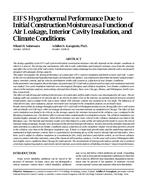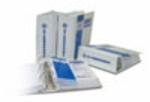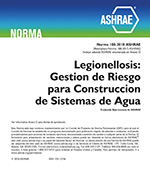Description
The drying capability of an EIFS wall system with initial construction moisture critically depends on the climatic conditions in which it is placed. The drying rate mechanisms with which walls redistribute and transport moisture away from the envelope may affect the service life of the wall system. Potential moisture-induced damage becomes important when the wall is not properly designed with adequate drying capacity. This paper investigates the drying performance of a particular EIFS (exterior insulation and finish system) clad wall. A state-of- the-art two-dimensional hygrothermal model, developed by the authors, was employed to determine the hourly spatial temperatures, moisture content, and air velocity distributions within wall systems as a function of real climatic conditions. In the parametric investigation, the performance of a particular EIFS clad wall as a function of two stud cavity insulation materials was studied. Two cavity insulation materials were investigated: fiberglass and cellulose insulation. Two climatic conditions were chosen in the moisture analysis, representing cold and mild climates; these were Chicago, Illinois, and Wilmington, North Carolina, respectively. The effect of wall drying and wetting in the presence of a particular airflow path (cracks) was investigated for all cases. The air leakage path was assumed to be present due to an electrical outlet close at the interior, an opening present between oriented strand panels, and a conduit in the stucco layer. Initial OSB moisture content was assumed to be very high. The influences of wind-driven rain, solar radiation, and air movement were included in the simulation analysis on an hourly basis. Results showed that air leakage through a particular EIFS clad wall in Wilmington produced a net drying effect for a wall system with an initially wet OSB layer, while air leakage developed a net seasonal moisture accumulation in Chicago. The effect of stud cavity insulation was found to be critical, as the storage capacity for moisture increased in the cellulose case, compared to the fiberglass insulation case. The distinct effect is present when comparing the two insulation systems. The cellulose insulation case retained higher amounts of moisture. Solar-driven moisture was also more critical in the cellulose insulation case than in the fiberglass case. The thermal and moisture results were then linked to a state-of-the-art mold growth model to assess the risk of moisture-induced damage. Results were developed in the form of mold growth indexes. Results showed the probable mold growth index potential as a function of climatic conditions and as a function of cavity insulation. Higher risk of mold growth is present in the cellulose case than in the fiberglass insulation case. If there is a high mold growth index and the underlying material is maintained at high moisture content, there is a potential for developing decay (if the wood is already infected internally). Since boric acid is added in cellulose insulation as a treatment for fire, mold, and insect and rodent control, as wet blown cellulose comes in contact with other materials, some of the chemical will treat these surfaces. For the same wall system, Wilmington exhibited slightly worse conditions than Chicago for mold growth. The development of mold growth indexes permits one to perform a moisture engineering analysis and extend current moisture assessment analysis of building envelopes’ long-term performance.
AUTHOR: Mikael H. Salonvaara, Achilles N. Karagiozis, Ph.D.
CITATION: Thermal Performance of the Exterior Envelopes of Buildings VII
KEYWORDS: December, Florida, 1998
YEAR: 1998
Citation: Thermal Performance of the Exterior Envelopes of Buildings VII
Product Details
- Published:
- 1998
- File Size:
- 1 file , 870 KB
- Product Code(s):
- D-8103




